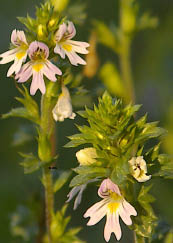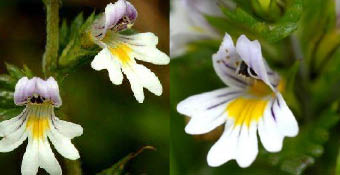|
Search Term: " Lilac "
Eyebright Herb
Date:
September 25, 2009 10:56 AM
When a bee visitor comes in search of the honey lying around the ovary at the bottom the petal tube, it knocks against the anther spurs, setting the pollen free so that it falls on the insect’s head. When visiting the next flower, the bee will then rub its head against the outstanding stigma, in which cross-fertilization takes place. The eyebright plant has white petals that have a red or purple tinge, resembling bloodshot eyes. It is this appearance that is thought to be the reason for the use of eyebright in treating eye irritations as far back as the Middle Ages. Topical applications of this herb were prescribed by Dioscorides and Theophrastus for eye infections.
The eyebright plant will not grow readily in a garden if it is transplanted unless it is protected by grass. The reason for this is that it is a semi-parasite and relies on its nourishment on the roots of other plants. Above ground, the plant appears to be a perfectly normal plant, with flowers and bright green leaves. But below the surface, suckers from its roots spread around and lie on the rootlets of the grass plants surrounding it. The grass preyed upon does not suffer very much. The eyebright plant, being an annual, renews itself each year. The entire eyebright plant is used to provide alterative, anti-inflammatory, antiseptic, astringent, bitter, and stimulant properties. The primary nutrients found in this herb are copper, iodine, iron, silicon, vitamins A, B, B-complex, C, D, and E, and zinc. Primarily, eyebright is extremely beneficial in dealing with blood impurities, cataracts, colds, conjunctivitis, eye disorders and infections, eyestrain, and glaucoma. Additionally, this herb is very helpful in treating black eyes, sinus congestion, coughs, hay fever, headaches, hoarseness, memory loss, and sties. For more information on the many beneficial effects provided by this herb, please feel free to contact a representative from your local health food store.
(https://vitanetonline.com:443/forums/Index.cfm?CFApp=1&Message_ID=2088) Licorice Root
Date:
May 23, 2008 11:53 AM
Medical professionals, especially in Europe and Japan, have been using licorice more and more in medicine. The Chinese consider licorice to be a superior balancing and harmonizing agent, so it is added to many herbal formulas. It is reputed in many countries, including the United States, to be a treatment for stomach, intestinal and many other problems. What is it used for? Antioxidant Properties Licorice is being studied for its effects against oxidation of LDL cholesterol, which is a major component in atherosclerosis. Approximately 300 different phytonutrient compounds found in natural licorice are considered possible antioxidants. Anti-Viral Properties Licorice is being tested for its ability to help prevent certain viruses from replicating themselves in body cells. It appears to stimulate the immune system into producing interferon, which is known for its anti-viral effects. It is an effective aid in treating herpes and hepatitis. Promising results are also being reported in tests using licorice to combat SARS, influenza and HIV. Stomach and Intestinal Problems Licorice is a natural home remedy for heartburn, gastritis and acid reflux. It helps to promote new cell growth in the lining of the stomach. It also enhances the stomach's self-protecting abilities. Licorice has been used to treat peptic ulcers and aid in healing other types of ulcers. Throat and Respiratory Problems Licorice is widely known in the world of alternative medicine as an expectorant and cough suppressant. Colds and flu have been treated with licorice since the days of the Romans. Many over-the-counter cough medicines contain licorice extract because it soothes the mucous membranes. Other Medicinal Properties
Is Licorice Safe? Licorice is not recommended for use by people who suffer from diabetes mellitus, heart disease, hypertension or kidney disease. It is also not recommended for use by women who are pregnant or breast-feeding. Side Effects Licorice, although not thought to suppress the immune system like pharmaceutical cortisones, may cause similar side effects in high doses. Some of these include weight gain, fluid retention and high blood pressure. Description and Cultivation The licorice plant stands up to five feet tall. It has spikes of Lilac-colored flowers that have bean-like pods containing three or four seeds apiece. The root, which is used most frequently, reaches underground about three feet and branches into networks of rhizomes. After three to five years, the roots and rhizomes are cleaned, pulped, boiled and then concentrated by evaporation. The root, if kept dry, will keep for an indefinite amount of time. If the licorice is powdered, it should be stored in an airtight container. Licorice has been used for centuries in conjunction with established medicine, as an alternative herbal medicine, and as an herbal confection in many parts of the world. It is noted for its medicinal value in treating stomach, intestinal and other ailments, including helping to stimulate the immune system. Studies are ongoing to discover more potential uses for this naturally sweet herb.
(https://vitanetonline.com:443/forums/Index.cfm?CFApp=1&Message_ID=1797) | ||||||||||||||||||||

 The eyebright plant is elegant and small, growing between two and eight inches high. This plant is an annual, commonly growing on heaths and other dry pastures, especially on chalky soil. The plant flowers from July to September and has deeply cut leaves and small, white or purplish flowers. The stem is erect and wiry. It comes in either unbranched, small specimines, or with many opposite branches. The leaves are tiny, about 1/6 to ½ inches in length and opposite to one another on the lower portion of the stem. The flowers, which are white or Lilac, have purple veins and terminal spikes. The structure of the flower places the plant in the Scrophulariaceae family. The seeds in this flower are produced in tiny, flattened capsules, and are numerous and ribbed.
The eyebright plant is elegant and small, growing between two and eight inches high. This plant is an annual, commonly growing on heaths and other dry pastures, especially on chalky soil. The plant flowers from July to September and has deeply cut leaves and small, white or purplish flowers. The stem is erect and wiry. It comes in either unbranched, small specimines, or with many opposite branches. The leaves are tiny, about 1/6 to ½ inches in length and opposite to one another on the lower portion of the stem. The flowers, which are white or Lilac, have purple veins and terminal spikes. The structure of the flower places the plant in the Scrophulariaceae family. The seeds in this flower are produced in tiny, flattened capsules, and are numerous and ribbed.  For centuries,
For centuries, 



